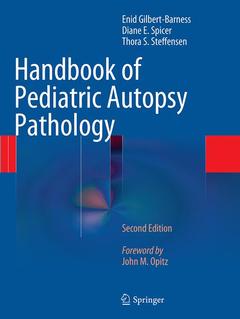Description
Handbook of Pediatric Autopsy Pathology (2nd Ed., Softcover reprint of the original 2nd ed. 2014)
Authors: Gilbert-Barness Enid, Spicer Diane E., Steffensen Thora S.
Language: EnglishApproximative price 231.04 €
In Print (Delivery period: 15 days).
Add to cartPublication date: 10-2016
Support: Print on demand
Approximative price 316.49 €
In Print (Delivery period: 15 days).
Add to cartPublication date: 09-2013
750 p. · 21x27.9 cm · Hardback
Description
/li>Contents
/li>Biography
/li>Comment
/li>
Pathologists have long recognized that pediatric autopsy requires great care in technique and dissection to ensure that easily overlooked malformations are recognized and accurate diagnoses are made. The highly experienced authors have created a new edition of Handbook of Pediatric Autopsy Pathology, a comprehensive reference guide to the actual performance of the pediatric autopsy and the optimal recognition and interpretation of pathologic findings. The Handbook of Pediatric Autopsy Pathology, Second Edition covers the spectrum of pediatric pathology with particular reference to those conditions that can be identified at autopsy.
New and updated material includes microbiological studies, particularly with the advent of newly described micro-organisms causing disease. The volume also addresses new developments in metabolic diseases, new techniques of ultrasound imaging, and specialized laboratory testing. Furthermore, the book provides a wealth of practical information and bibliographic citations throughout, new copious illustrations and line drawings, numerous standard reference tables, and appendices at the end of multiple chapters.
Authored by authorities in the field, Handbook of Pediatric Autopsy Pathology, Second Edition is a valuable resource that will assist general and pediatric pathologists, neonatologists, interns and residents in training, as well as specialists in cytogenetics and ultrasound technicians in understanding the manner and cause of death in its broadest and comprehensive sense.
1. Introduction and General Principles of the Autopsy
II. Techniques
2. Pediatric Autopsy: Fetus, Newborn, and Child
3. Examination of the Human Embryo
4. The Placenta
III. Developmental Disorders
5. Hydrops, Cystic Hygroma, Fetal Hydrothorax, and Fetal Ascites
6. Chromosomal Defects
7. Congenital Abnormalities
IV. Organ Systems and Metabolic Disorders
8. Cardiovascular System
9. Respiratory system
10. Gastrointestinal System
11. Liver, Gallbladder, Biliary Tract, and Pancreas
12. Renal System
13. Male and Female Genitourinary Systems
14. Central Nervous System
15. Thymus, Spleen, Lymph Nodes, and Immunodeficiency
16. Hematopoietic System
17. Pediatric Tumors
18. Skeletal System
19. Skin
20. Infections
21. Transplantation
22. Eye and Adnexa
With contributions from Mary Milne Gilbert-Lawrence
23. Metabolic Diseases
V. Special Considerations
24. Sudden Infant Death
25. Forensic Pathology
26. Special Procedures
27. Infection Control and Biological Hazards
Enid Gilbert-Barness, AO, MD, MBBS, FRCPA, FRCPath, DSci(hc), MD(hc), DSci(hc)
Tampa General Hospital, University of South Florida Morsani College of Medicine, Department of Pathology, Tampa, FL, USA
Diane E. Spicer, BS, PA(ASCP)
University of Florida, Department of Pediatrics-Cardiology, Gainesville, FL, USA
Thora S. Steffensen, MD
Tampa General Hospital, Department of Pathology, Tampa, FL, USA
Expert guidance to performing a pediatric autopsy
Cutting-edge methods that demonstrate great care in technique and dissection
Expansion on the application of molecular and special procedures such as DNA determination, enzyme analysis, and microarrays
Numerous color illustrations, diagrams, and standard reference tables




